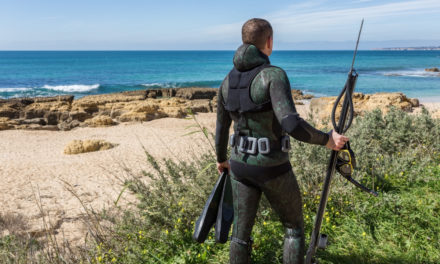There are thousands of spearfishing shafts available on the market, typically causing you confusion when it’s time to get a new one. With many variables, such as weight, diameter, and length, it’s only fair you get some help before purchasing.
In this article, we’ll review the best spearfishing shafts on the market, and we’ll include a buyer’s guide to give you an all-inclusive view of the features before buying.
Essential Features to Consider When Choosing a Spearfishing Shaft
Choosing the wrong spearfishing shaft will probably ruin your next fishing trip, may damage the gun, and will cost you to buy another one. You can make matters easier for yourself and consider all possible factors, so you get the right shaft on your first try.
Here’s a roundup of the essential features to consider.
Diameter
The shaft’s diameter maybe its most essential factor because it directly affects all the other features, including the weight. Shaft diameters can range from 6mm to 8mm.
Higher diameters have more friction with the water, thereby increasing drag and causing the spear to lose energy quickly. They also result in a less strong initial start because of the increased mass.
In other words, a thick shaft will travel in the water slowly, and it’ll cover less distance, making it an ideal choice for large fish in a close range. Bear in mind that the low striking force may help the fish, though, if you shoot from far away. Shafts with thick diameters need to be hit with great accuracy.
On the other hand, thinner shafts move faster, and they’re better at covering distances. However, they lose momentum quickly when shot from a short distance. As a result, they don’t penetrate deep enough to catch big fish. Additionally, thin shafts don’t provide as much stability as thick ones.
Weight
The shaft’s weight depends on both the material and the diameter. Lighter shafts have a faster muzzle velocity, but that doesn’t necessarily mean a longer effective range. In fact, light shafts lose momentum faster than heavy ones, giving heavy ones leverage for catching large fish.
Heavy spearfishing shafts typically require more power, but they’ll go further if you power them properly. They also cause more recoil than lighter ones, so they need a heavy gun.
Length
Your shaft length choice should depend primarily on the size of your gun. The shaft should extend around 10 inches from the muzzle’s end. Generally, longer shafts account for more accuracy, but only if the gun’s size allows it.
If the shaft you choose is too long for your gun, the gravitational bend at the gun’s tip will pull your shot down. On the other hand, if your shaft is too short for your weapon, it’ll be overpowered, resulting in low stability.
A lot of manufacturers make shafts in the same size as already-existing guns for that reason. That way, you can choose the most accurate length for your weapon.
There are some other considerations you should keep in mind. For instance, a thin shaft shouldn’t be too long because it would easily bend. At the same time, long shafts are easier to aim because they’re easier to see.
A shaft with a shorter length is easier to maneuver in tight spaces, though, and it won’t bend.
Material
There aren’t many materials on the market for spearfishing shafts, so the choice shouldn’t be hard. Here are the three most common materials you’ll find.
Spring Stainless Steel
Spring stainless steel has the properties of both spring and stainless steel. As a result, it’s highly durable and solid, but it’s flexible enough to bend if you need it to. It doesn’t stay bent, too, which is a good quality to have.
Spring stainless steel is also heat-treated for added strength and hardness, and it doesn’t rust or oxidize. It’s a bit costly, but it’s worth every dollar you’ll pay for it because you likely won’t need to replace it soon.
Carbon Steel
Carbon steel is an incredibly tough material; it’s highly durable and rigid, which means it won’t bend as well as spring stainless steel does.
Carbon steel shafts have an external layer of dark or gold coating to prevent them from oxidizing. While this coating accounts for more durability, it comes with some downsides. It’ll start coming off after a while near the tips, mainly resulting from shooting into rocks and penetrating fish flesh. As a result, the shaft will rust faster than it should.
Sandvik Steel
Sandvik steel is less common than the other types, and it costs a lot more. It’s a bit similar to spring stainless steel, except it’s more rigid. It doesn’t rust or oxidize, so you won’t need to buy a new one anytime soon.
Sandvik steel shafts are only heat-treated from the middle. Their tips aren’t heat-treated to keep them as strong as possible for penetrating the fish. On top of that, the back halves aren’t heat-treated to prevent them from bending.
The 5 Best Spearfishing Shafts on the Market
We chose these spearfishing shafts because of their reliability, durability, and functionality. We included various budgets as well, so you can find your best match easily.
Cressi 6.5mm 174PH Tahitian Notched Shaft
If you’re not a fan of finned spearfishing shafts, you may consider this smooth-notched one from Cressi. The Italian spearfishing brand has been making reliable equipment for a long time, and this shaft is no exception.
It’s pretty affordable, as all notched spears are. On top of that, it sports a single flopper, Tahitian-style.
The shaft is manufactured from tempered stainless steel, which is resistant to corrosion and strong enough not to bend or break upon impact. It goes perfectly well with Yuma, Comanche, and Mohicano spearguns from Cressi.
Rob Allen 7mm Notched Euro Spear Shaft
The Rob Allen is one of the best-notched shafts on the market. It’s available in both 7mm and 7.5mm diameters, and it’s made from tough carbon steel. The material resists shattering and snapping while showing some pliability under high pressure. Not only that, but it also doesn’t stay bent after flexing.
The notches are smooth and polished, making them ideal for accommodating Dyneema wishbones without causing them to wear out. Additionally, the tri-cut tip is highly durable and solid, accounting for efficient penetration of the fish flesh.
After being polished, the Rob Allen shaft goes through zinc plating to increase its resistance to corrosion and rust. It likely won’t show any signs of rust for a long time.
If you’re not a fan of notched spears, Rob Allen also makes similar finned ones.
PATHOS SANDVIK SHARKFIN SHAFT
The Pathos shaft is the only one on this list made of Sandvik steel, which is known for its durability, hardness, and corrosion resistance. It’s also the reason the shaft is a bit costly since the steel undergoes positioned heat treatments.
Sandvik steel shafts get heat treated only from the middle section. The top and rear are left out of the treatment to avoid bending and keep them strong enough to penetrate the fish flesh.
The shaft has three shark fins positioned far from each other. They’ve been deburred and chamfered, making their edges smooth enough for Dyneema wishbones and metal bridles.
The Pathos shaft is made for sniper roller spearguns.
PICASSO GOLD PLATED 7.0MM SHAFTS
The Picasso spearfishing shaft is affordable, reliable, and durable. It has an external layer of gold coating to make it more resistant to corrosion and give it a sleek look.
The shaft is notched, making it an ideal choice for closed muzzle guns. That’s also why it’s much more affordable than its finned counterparts. The notches are smooth and polished; they can be used with Dyneema wishbones.
The shaft is made from high tensile spring steel; the material has been heat-treated to 57-58 Rockwell, giving it solid resistance to bending and breaking. It’s available in multiple lengths, so you can land the best option for your speargun.
MORI STAINLESS STEEL SPEAR SHAFTS
Mori spearfishing shafts are known for their reliability and functionality. This one is made of 17-4 PH stainless steel, like most shafts on the market. It’s also heat-treated to 46 Rockwell to increase its hardness, ductility, and corrosion resistance. You’d have to wait a long time before this shaft rusts; you’ll likely not own it long enough for it to do so.
The Mori shaft comes with three shark fins, highly polished and positioned near the rear for better band stretch. There are models available with flopper tips and others with threaded tips, so you can choose whatever suits your gun the best. There are also both American and Euro notches available for purchase.
American Notch vs. European Notch
All spearfishing shafts have a notch at the end, but they come in different shapes. Some notches are squared; these are American-style. And, there are crescent-shaped ones, European style. These are the two most common notches on the market.
Each notch is made for a different trigger mechanism, so you ought to know the difference to make the right choice. Here’s a brief overview of each type of notch.
American Notch
American notches are square-shaped, and they typically come in 15/6 inches or 8mm diameters. Shafts thinner than that pose a risk of being damaged or snapping if they’re dropped or handled out of the water. The notch is typically the shaft’s weakest point, so it’s at more risk of breaking.
American-style shafts give a higher load rating. They’re able to hold much more weight than their European counterparts, reaching up to 175 pounds. They’re perfect for catching pelagic fish species, such as marlin, dogtooth, and wahoo, and they’re suitable for blue canyon waters fishing.
American shafts use multiple bands, which is why they hold a higher load than other ones.
European Notch
European notches come in the shape of a crescent or a semicircle cut into the shaft’s rear. The manufacturers originally intended it as a universal shape for shafts. The type of mechanism didn’t matter then because they thought it’d fit through, anyway.
These notches allow you to do the rigging through the back because they have more room for entrance—at least more than their American notch counterparts.
European notch shafts are available in a wide range of materials, including stainless steel, spring steel, and high carbon steel. Meanwhile, American notches are usually only available in stainless steel. If you have a European notch, you can use it on any Euro-style speargun.
It’s worth noting that you can’t use a European notch for an American trigger mechanism and vice versa. So, make sure to make the notch choice according to your gun style.
Frequently Asked Questions About Spearfishing Shafts
If you’re still confused about anything regarding spearfishing shafts, these answers to frequently asked questions will hopefully help a bit.
Is the shaft diameter important?
Of course. Shaft diameter is an essential factor when choosing your shaft because it affects the weight as well. For example, a small-diameter shaft will be typically lighter than a thick one. That means it’ll move fast towards the fish in a close range, which helps catch small fish who move fast.
Additionally, a thin shaft will have less momentum than a thick one. As a result, it won’t get damaged if it comes in contact with rocks or any hard surface, making it an ideal option for beginners.
On the other hand, thick shafts are better for targeting larger fish because they provide more penetration power.
All in all, the diameter can make or break the shaft’s efficiency.
When do I need to attach a float line to the shaft?
If you’re going to target large fish, then you’ll need to attach a float line. It’ll help you slow down the fish and catch it. It’s worth noting, though, that you shouldn’t connect the float line to the gun itself.
In this case, your gun may get damaged if the fish decides to thrash around and fight for its life. If the fish is powerful enough, it can even cause you to drop the speargun and lose it. For further information on the correct float line take a look at these two articles – spearfishing float line.
Can I shoot my shaft from above the water?
It’s not recommended. In fact, it can have fatal results when loading or unloading the gun. Spearfishing guns aren’t designed for out-of-water use, and shooting from outside won’t allow you to make an accurate aim.
In addition to that, the shafts aren’t intended to hit the water from outside. They’ll lose their momentum much faster than they should upon impact. It’s better not to try spearfishing from above the water altogether.
What’s the right spearfishing shaft for big-game fish?
To catch big-game species, you’ll need to be armed with a solid tip that’s capable of penetrating nearly two feet of the fish’s flesh. Otherwise, the shaft will tear free of the fish if it fights for its life. Bear in mind that catching such fish needs a durable, robust spear shaft. You may want to consider ones made of spring steel, carbon steel, or aluminum.
How should I store a spear shaft?
Before storing your spearfishing shaft, you should rinse it with cool fresh water and leave it to dry. The remnant of salty water can cause it to rust and wear out if left for long.
Afterward, check for any signs of corrosion or damage, especially if your shaft is made of aluminum or another pliable material. Shafts mostly break at their notches because they’re their weakest point, so that’s the first thing you should check.
When you’re done, store the shaft in a cool, dry place. If you store it somewhere moist, it may rust if the material isn’t resistant to corrosion.
Are shorter or longer shafts better for beginners?
Shorter length shafts are the better option for beginners. Longer shafts give a greater range, which means you won’t need to get close to the fish you’re targeting. However, they’re harder to maneuver underwater, and they need some getting used to before you master them.
Shorter shafts are generally easier to use and aim for targets at a close range. That being said, remember that your choice should primarily depend on your gun size.
The Final Verdict
Our top pick for spearfishing shafts is the Rob Allen 7mm Notched Euro Spear Shaft. It’s hard enough to show resistance to breaking, but it’s pliable enough to bend if you need it to. Additionally, it goes back to its initial position instead of staying bent, thanks to the top-notch high carbon steel build.
One more feature we love about the Rob Allen shaft is its tri-cut tip, which penetrates into fish flesh like it’s nothing.
If you prefer a spear with shark fins rather than a notched one, we recommend the MORI STAINLESS STEEL SPEAR SHAFT. It’s made out of high-quality stainless steel, heat-treated to ensure maximum strength. It’s also available with flopper and threaded tips and European and American notches, so you can land your best match easily.



![The Very Best Spearfishing Bags [Buyer’s Guide]](https://spearoscout.com/wp-content/themes/Extra/images/post-format-thumb-text.svg)

![A Guide To Freediving Gear [For The Beginner]](https://spearoscout.com/wp-content/uploads/2019/03/Spearfishing-freedivng-440x264.jpg)
